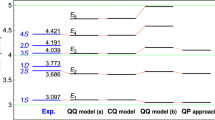Summary
It is shown that slowly and smoothly decreasing hadron form factors (e.g. of the dipole type) are inconsistent with a confining quark potential in nonrelativistic quark models. Relativistic effects are able to remedy the situation. This is shown by presenting a quasi-relativistic quark model based on a specific assumption about the approximate behaviour of the gluon cloud amounting to a model ofdressed quarks with momentum-independent energies, but with no additional gluons. The large anomalous magnetic moment of the proton can only be understood when all three quarks are treated on equal footing as in the bag model, ruling out the quark-diquark hypothesis.
Riassunto
Si mostra che i fattori di forma adronici che diminuiscono lentamente e in modo lineare (per esempio del tipo dipolare) non sono in accordo con il potenziale di quark confinante in modelli a quark non relativistici. Gli effetti relativistici sono in grado di rimediare la situazione. Ciò è mostrato presentando un modello a quark quasi relativistico basato su un’ipotesi specifica circa il comportamento approssimato della nuvola di gluoni, il che corrisponde ad un modello di quarkvestiti con energie indipendenti dall’impulso ma con nessun gluone addizionale. Il grande momento magnetico anomalo del protone può essere compreso solo quando tutti e tre i quark sono trattati in maniera uguale come nel modello a sacco, eliminando l’ipotesi del quark-diquark.
Реэюме
Покаэывается, что медленно и плавно увеличиваюшиеся адронные форм-факторы (т.е. дипольного типа) не согласуются с удерживаюшим кварковым потенциалом в нерелятивистских моделях кварков. Релятивистские зффекты могут исправить ситуацию. Для иллюстрации зтого предлагается кваэи-реляти-вистская кварковая модель, основанная на специфическом предположении о приближенном поведении глуонного облака, которое сводится к модели « одетых » кварков с знергиями, не эависяшими от импульса, но беэ дополнительных глуонов. Больщой аномальный магнитный момент протона можно понять только при условии, что все три кварка рассматриваются на равных основаниях.
Similar content being viewed by others
References
J. F. Gunion andR. S. Willey:Phys. Rev. D,12, 174 (1975).
H. J. F. Müller-Kirsten:Phys. Rev. D,12, 1103 (1975).
H. J. Schnitzer: Brandeis University report (unpublished).
H. J. Schnitzer:Phys. Rev. D,12, 2791 (1975).
M. Gourdin:Phys. Rep.,11 C, 29 (1974).
Author information
Authors and Affiliations
Additional information
To sped up publication, the author of this paper has agreed to not receive the proofs for correction.
Rights and permissions
About this article
Cite this article
Hamprecht, B. Hadron form factors in a quasi-relativistic quark model with a confining potential. Nuov Cim A 38, 279–294 (1977). https://doi.org/10.1007/BF02730025
Received:
Published:
Issue Date:
DOI: https://doi.org/10.1007/BF02730025




